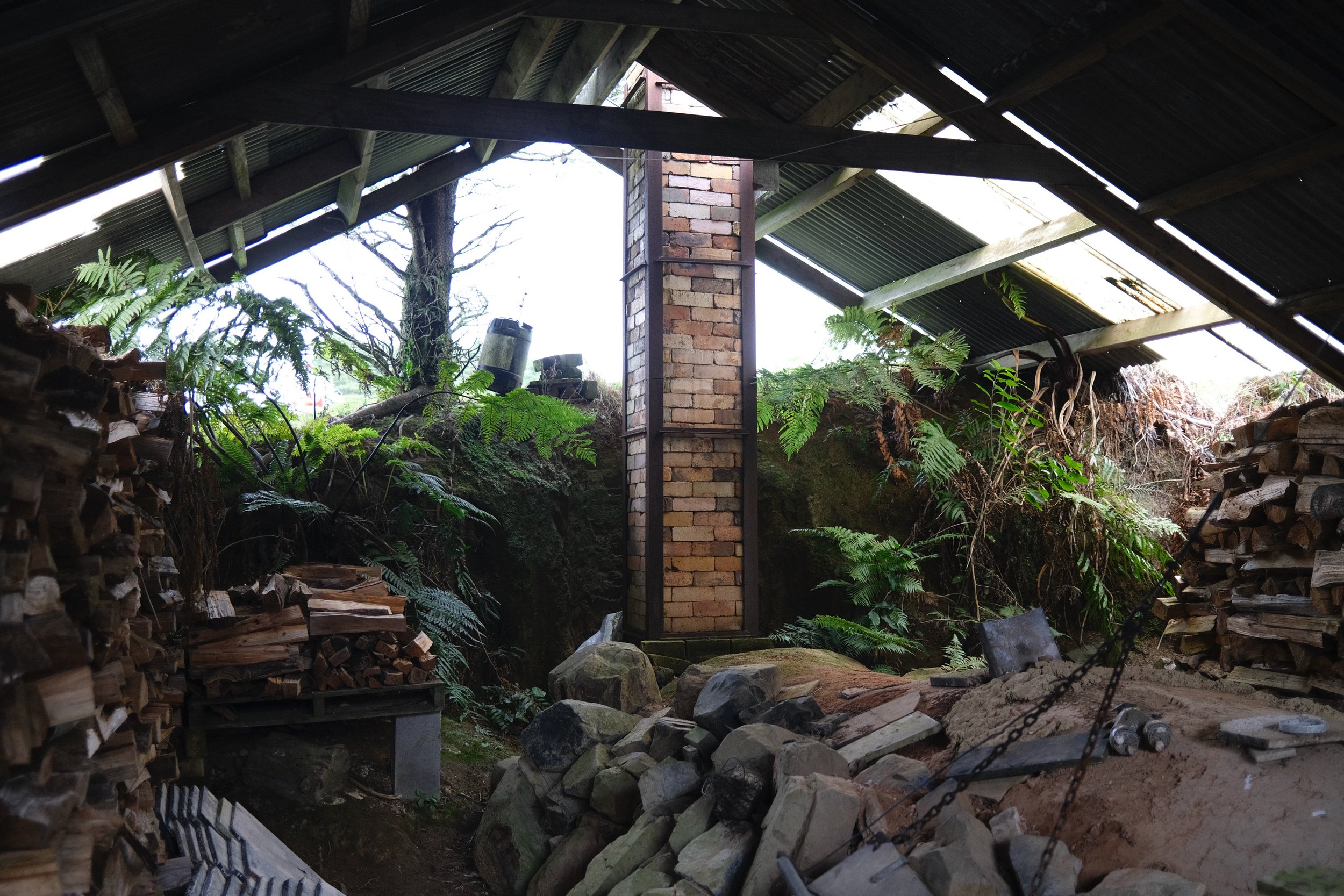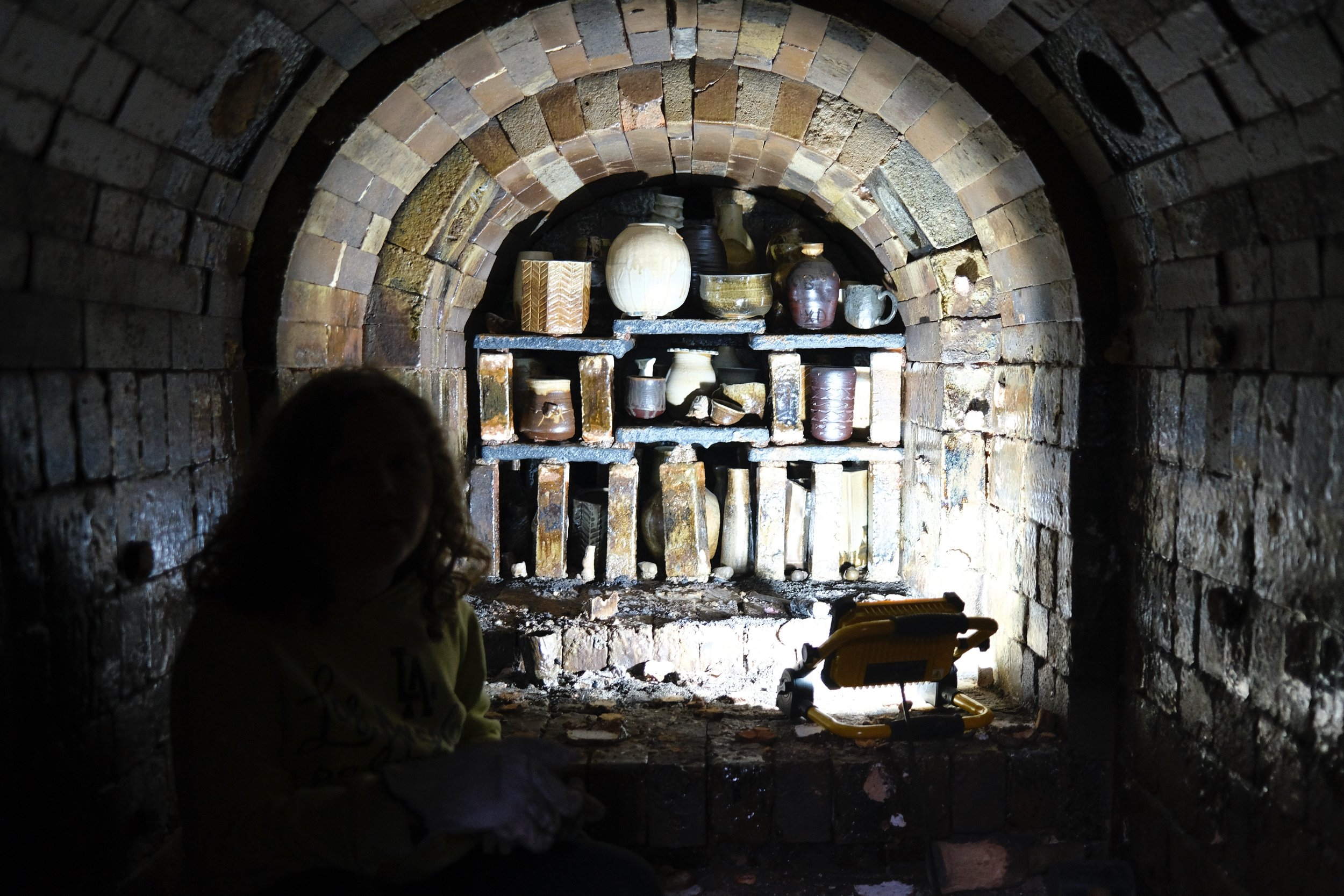Our Anagama Kiln
“The great appeal of anagama firing is its total unpredictability so that each piece is unique in its character and can never be repeated. Deliberately inefficient and taking considerable amounts of wood, an anagama kiln will reveal the effects of flame, ash and vitrification that make the wares unique.”
Chester Nealie (one of Australasia’s greatest exponents of wood firing)
Te Haunui Anagama
One of the club’s hidden gems is a Japanese styled anagama wood fired kiln nestled in Horokiwi. One of very few in New Zealand, it is fired annually.
The firings draw a hard core of devotees attracted by the firing process, the hospitality, the venue and, importantly, the often exciting and unexpected results that emerge when the kiln is opened.
First fired on 18 March 2006, construction of the kiln started in 2004. It was initiated by Richard Stratton with the support of Andy Hope. Their vision was made possible by the generosity of Graeme and June Houston who made land available for its construction on their Te Haunui property in Horokiwi. Graeme also ensured that the kiln was nourished with a steady supply of heavily discounted firewood. Shige Ohashi, a veteran of over 50 anagama firings in Japan, produced a detailed set of plans and provided technical oversight for the project. The building of the kiln and its shelter was the product of the work of an energetic group of enthusiasts comprising Wellington Potters’ Association members and a number of non-members (most of whom were non-potters) who got caught up in the spirit of the enterprise.
A core group of pyromaniacs plan the firings, maintain the kiln and its shelter, clean kiln shelves, prepare firewood, and load the kiln. In 2022, the Anagama organising team was comprised of Ian Gear, Mal Sole, Julie Harrington, and Anneke Borren supported by many other volunteers, without whose contributions, the firing wouldn't be as successful.
Plans of the kiln - Anagama brick settings
(click to enlarge images)
Front view
Cover Mouth
Layer Arch
Inner Size - Level
Shige Ohashi’s Firing Philosophy
Prior to his return to Japan in 2016, Shige Ohashi was the principal firing master for most of the firings. A very able teacher, Shige gave freely of his knowledge, experience and anagama philosophy. Anticipating his return, he actively recruited and mentored people to assume responsibility for loading and firing the kiln, in order to reduce the club’s dependence on him.
Shige developed a philosophy about such firings which greatly influenced those involved. The main elements of his philosophy were included in an article “Thoughts on the Anagama Firing” published in the August 2012 edition of the Wellington Potters Association’s newsletter:
“Prologue
‘Inevitability’, ‘Accident’ and ‘Time’. These are my favourite key words. Nature and Life on the Earth were born from these key words. If I could feel them in something, it would touch my heart. Anagama firing may give it to me, although it is very, very small compared with happenings in the universe.Loading
I will load each piece as to get good ‘Inevitable’ results of the firing on it as much as possible. When I put a piece on a shelf, I imagine how the flame flows and how much wood ash the flame contains. The pieces on the shelves are decorated with the flame and ashes, or shadow of other pieces.
At completion of the loading, the Anagama firing is over 50% done.Firing
it’s a fun time. Things we can do are not so many. Stoke pieces of firewood believing in the power of the Anagama kiln for about 100 hours. If you believe in the kiln, it may give us a beautiful ‘Accident’.A time of 100 hours is long. During stoking firewood, we not only increase the temperature, but also make up the natural glaze with wood ashes and apply it on the pieces little by little. It’s Time.
We can’t control everything happening in the kiln. I want to have the kiln fire our pieces without human’s petty thinking. However, we have to feed the energy of the firewood to the kiln effectively. We need to understand the current situation/condition of the kiln. Sitting just before the kiln, listen to the kiln and communicate with the kiln. It’s a delightful time.
Expectation of your piece
Do not expect a good result on your piece. Such expectation will disappoint you. The results on your piece will never be like what you expect. Please expect the unexpected. Please try to find a beautiful face on your piece after the firing. Your piece had been standing in the massive flame for 100 hours long. It must give us good hints for the next firing.”
The Anagama Sermon
A sermon from the firing pit, delivered by the irrepressible Mal Sole, marked the opening of the Te Haunui anagama kiln on Sunday 25 September, 2016. It recognised the collective efforts of those who contributed to the very successful 12th firing and captures the essence of what is involved.
“Blessed are the tree deliverers for they shall be given forests in heaven plus one or two quarries.
Blessed are the chainsawers who reduce the trees to manageable lengths for they shall be given peace and quiet and a back that does not ache.
Blessed are the wood splitters for they shall form a splinter group on entering heaven.
Blessed are the wood stackers for they shall be entertained and never allowed to be bored to death again.
Blessed are the prop and shelf cleaners for they shall forever more breathe air that does not smell of China Clay, Alumina Hydrate and Carborundum, and have hair that is un-matted and non-gritty.
Blessed are the loaders for they shall receive approbation and brickbats and inherit the wadding.
Blessed are the pyromaniacs who transform the bland into the grand for they shall witness the collapse of the cones and be glazed for eternity.
Blessed are the unloaders for they shall form links in an eternal chain.
Blessed is the scone and soup maker that unfreezes and nourishes the great unwashed.
Here endeth the lesson.”
Footnote: For the uninitiated, the references to “quarries” and “the scone and soup maker” are allusions to the activities of Graeme and June Houston, respectively, on whose property the kiln is located.





